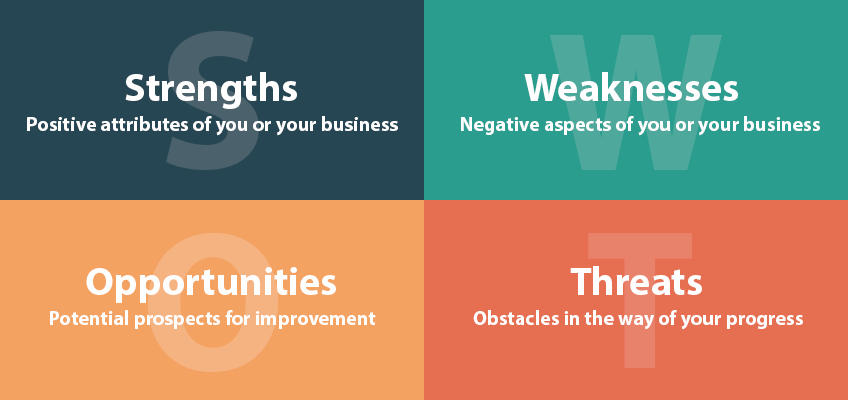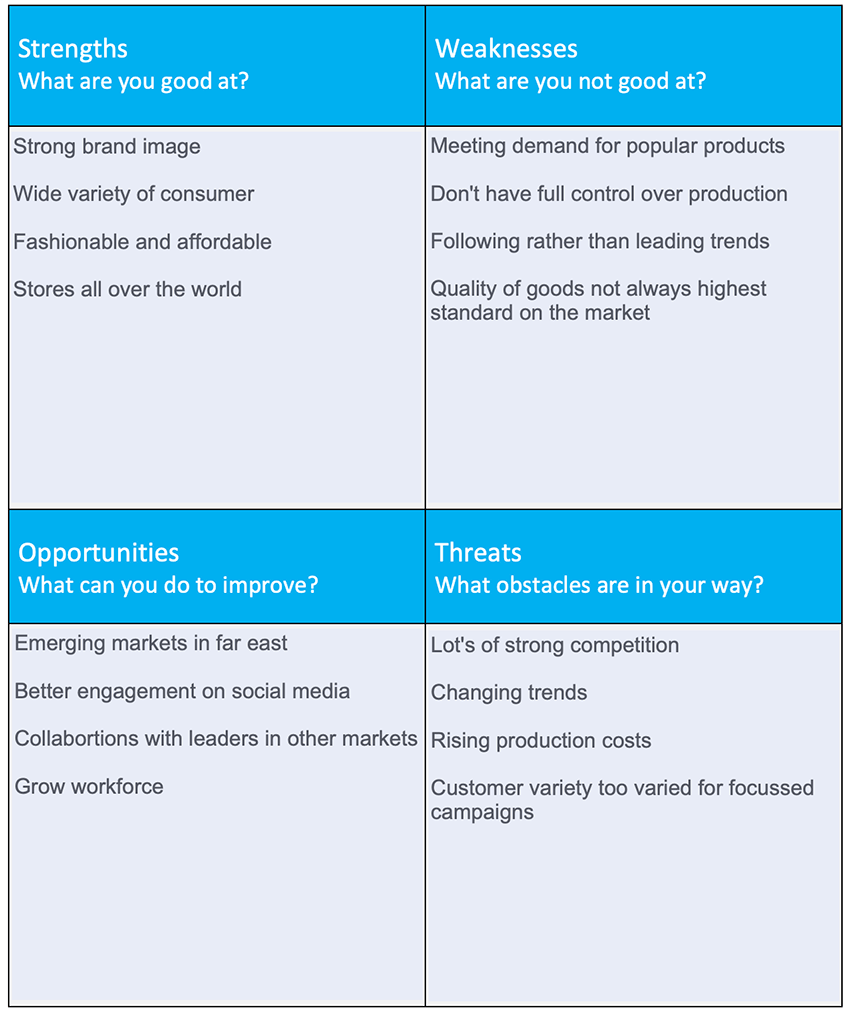If you are looking for a new business strategy, it’s important to analyze your business as it currently stands. Some of the questions you should be asking are:
- What is already working well? (Think about your strengths)
- What isn’t working well? (Your obvious weaknesses)
- What can help improve the business? (Opportunities available to you)
- What obstacles are in the way? (Threats that could halt your progress)
As a result of answering these questions you will have a clearer picture of your business. And the best way to do this is by using a technique called SWOT Analysis.
Definition of a SWOT Analysis
SWOT stands for Strengths, Weaknesses, Opportunities, and Threats. These 4 areas of your business are analyzed and drawn up on a matrix to give you a clear picture of your business.
What is a SWOT Analysis for?
Analyzing these four areas of your business will give you the foundation blocks for a strategy to move your business forward. Many business owners can’t see the woods for the trees when it comes to their own company. Being involved in the day to day running of all aspects of your business can blind you from the bigger picture. Therefore, you may have lost sight of the initial goals you set out to achieve.
A SWOT Analysis is aimed at looking at the big important factors that impact your business. By stopping and thinking about your Strengths, Weaknesses, Opportunities and Threats, you will be able identify a clear strategy for progressing your business. This tends to be one of the first steps a business takes when setting out a strategy. In essence, the finished analysis will allow you to set clear objectives and define targets.
How to do a SWOT Analysis of a company
A SWOT Analysis is done by filling out a simple matrix with four separate areas for Strengths, Weaknesses, Opportunities and Threats. You can download our SWOT Analysis Template and give it a try.

You can do a SWOT Analysis on your own or with a group of people. To get a wider perspective I would suggest using people from various departments if you have a large company. Some businesses also bring in external sources such as customers to get a point of view from the consumer. It is important that whoever does the SWOT analysis must have an in-depth understanding of how the business works.
Let’s look at the four elements and some examples of things you can add to each one:
Strengths
Listing your strengths might be difficult for the modest of you out there but it’s important to identify what you or your business is good at. Try not to add strengths that all of your competitors might also have. This is about identifying strengths that are unique and make you stand out from the crowd. You might want to add strengths such as:
- Something unique about your business. Something that particularly sets it apart from your competitors
- Advantages you have over your competitors
- Your story and why it’s important
- Good understanding of and relationship with customers
Weaknesses
We all know what our weaknesses are but sometimes it’s hard to admit to them. But it’s vital you lay all of your cards on the table here if you want to overcome your shortcomings. Examples of weaknesses might be:
- Lack of resources or finances
- Skills gaps
- Poor knowledge of target audience
- Poor branding or message
Opportunities
It’s always a good idea to follow the latest movements within your industry. Consumer trends might be changing and it’s important to stay a step ahead. I would also suggest keeping an eye on your competitors movements. For this section It’s likely you will want to identify some of the following:
- Potential partnerships or collaborations with businesses within and out-with your industry
- Available funding or investments
- Training opportunities
- Gaps in the market
Threats
Identifying threats to your business could help you eliminate them before they occur. Similar to Opportunities you should be looking out for the latest movements in your market. As well as these external threats, you should also identify internal threats. Here are some examples:
- Market becoming crowded
- Shifting market trends
- Budget issues relating to rising production costs
- Staff or skills shortages
How to do a SWOT Analysis of a Person
A SWOT Analysis isn’t just for businesses or organisations. You can also undertake a SWOT analysis of yourself which is great for your own professional development. In effect, the principles are still the same. List your personal Strengths, Weaknesses, Opportunities and Threats based on your own professional skills and situation.
A personal SWOT analysis will identify areas where you can develop your own abilities as well as your career aspirations. It will also help you realise where you have gaps in your skill set and how you can improve this. Download our SWOT Analysis Template and give it a try.
Examples of SWOT Analysis
Below is an example of a SWOT Analysis for a well known fashion company using our template.

Here is an example of a SWOT Analysis of a person using our template.

You can also use a SWOT Analysis for individual projects or areas within your business. The procedure is still the same whatever you choose to use it for.
Should you do a SWOT Analysis?
I would recommend all businesses do a SWOT Analysis at some stage. All of the major ones do. You may think you already have a firm grasp of your company and also feel that everything is running smoothly. But the world moves fast and trends can change overnight. In view of this, you should prepare to move with these changes or you might find yourself left behind.
As we have shown a SWOT analysis can be done very easily and many business owners are left amazed at gaps in their company after the analysis, particularly when identified by external sources. As a result, the analysis will show you how you are seen by others.
A SWOT Analysis could be the first and consequently the most crucial step you take to grow your business. With a good solid analysis you can move on to developing a plan by setting clear objectives.




